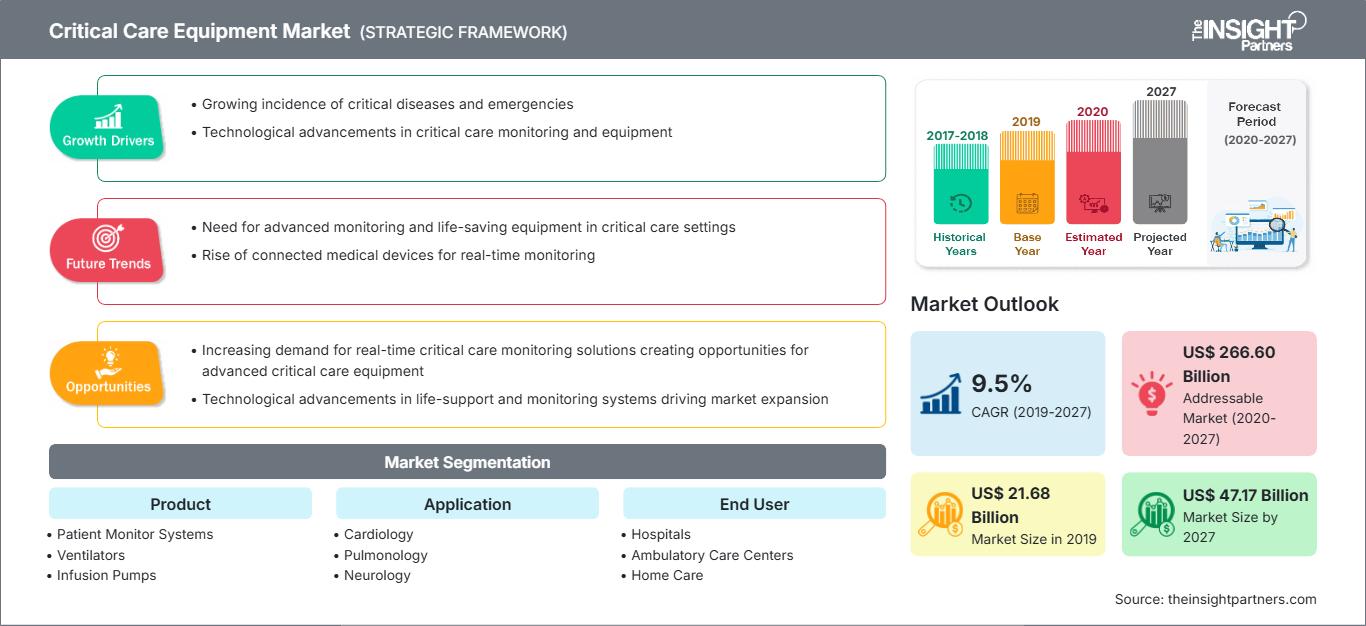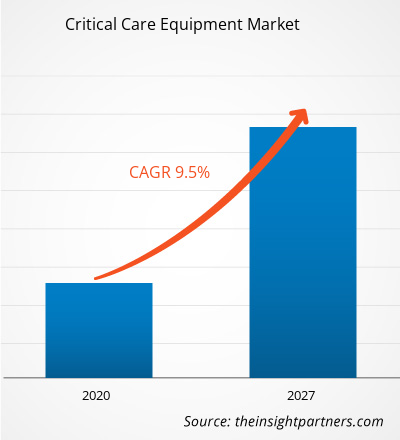중환자 치료 장비 시장은 2019년 216억 8,265만 달러 규모였으며, 2027년에는 471억 7,142만 달러에 이를 것으로 예상됩니다. 2020년부터 2027년까지 연평균 9.5% 성장할 것으로 예상됩니다.
중환자실 병상은 중환자실 수준의 치료를 수행할 수 있도록 장비와 인력을 갖추고 있으며, 침습적 모니터링과 함께 기계적 환기를 제공합니다. 국립생명공학정보센터(NCBI)에 따르면, 2020년 5월 캐나다는 COVID-19 발생이 정점에 달했을 당시 자가 격리율이 40%에 달했음에도 불구하고 중환자실 병상 수요가 상당히 초과되었습니다. 각 지역의 기존 중환자실 병상 수는 1만 명당 0.63개에서 1.85개 사이였습니다. 현재 병상 점유율이 80%라고 가정할 때, COVID-19 환자를 위한 빈 중환자실 병상 수는 지역별로 1만 명당 0.13개에서 0.37개까지 달라질 수 있습니다.
감염 환자들은 평균 15일을 중환자실에서 보내고 있습니다. 유럽마취학회에 따르면 이탈리아의 중환자실 병상 수는 계속해서 증가하고 있습니다. 코로나바이러스 확산 이전에는 롬바르디아주에 개인 중환자실 병상 140개와 공공 중환자실 병상 500개가 있었는데, 2020년 3월 말까지 900개 이상으로 증가했습니다.
요구 사항에 맞게 이 보고서를 사용자 정의하십시오.
이 보고서의 일부, 국가 수준 분석, Excel 데이터 팩을 포함하여 모든 보고서에 대한 사용자 정의를 무료로 받을 수 있을 뿐만 아니라 스타트업 및 대학을 위한 훌륭한 제안 및 할인을 이용할 수 있습니다
중환자 치료 장비 시장: 전략적 통찰력

- 이 보고서의 주요 주요 시장 동향을 확인하세요.이 무료 샘플에는 시장 동향부터 추정 및 예측에 이르기까지 데이터 분석이 포함됩니다.
시장 분석: COVID-19 유병률이 높은 국가의 중환자실 병상 증가로 시장 성장 견인
이 보고서의 일부, 국가 수준 분석, Excel 데이터 팩을 포함하여 모든 보고서에 대한 사용자 정의를 무료로 받을 수 있을 뿐만 아니라 스타트업 및 대학을 위한 훌륭한 제안 및 할인을 이용할 수 있습니다
중환자 치료 장비 시장: 전략적 통찰력

- 이 보고서의 주요 주요 시장 동향을 확인하세요.이 무료 샘플에는 시장 동향부터 추정 및 예측에 이르기까지 데이터 분석이 포함됩니다.
COVID-19는 2020년 3월 11일 세계보건기구(WHO)에 의해 세계적 대유행으로 선포되었습니다. 이 신종 질병은 초기 확진자 수가 적었다가 이후 여러 국가에서 감염이 폭발적으로 증가하는 것이 특징입니다. COVID-19 확산을 막기 위한 봉쇄 조치에도 불구하고, 여러 국가의 의료 시스템은 중환자실 병상 및 중증 환자 치료를 위한 보조 장비 등 장비 수요로 인해 과부하 상태에 있습니다.
제품 분석
제품 측면에서 환자 모니터링 시스템 부문은 2019년 시장 점유율 1위를 차지했으며, 예측 기간 동안에도 시장 선도 기업으로서의 입지를 유지할 것으로 예상됩니다. 그러나 인공호흡기 부문은 예측 기간 동안 시장에서 더 높은 CAGR을 기록할 것으로 예상됩니다.
응용 분야 인사이트
응용 분야를 기준으로 전 세계 중환자 치료 장비 시장은 심장학, 폐의학, 신경학, 정형외과 및 기타 분야로 구분됩니다. 심장학 부문은 2019년 시장 점유율 1위를 차지했으며, 폐의학 부문은 예측 기간 동안 가장 높은 CAGR을 기록할 것으로 예상됩니다. 심혈관 중환자 치료는 혈관 질환 및 심장 질환을 포함한 중증 심혈관 질환(CVD) 환자를 체계적으로 관리하는 것입니다. CVD는 전 세계 사망 원인 중 상위권에 속합니다. 예를 들어, 세계보건기구(WHO)에 따르면 2016년 약 1,790만 명이 심혈관 질환으로 사망했으며, 이는 전 세계 사망자의 31%에 해당합니다. 마찬가지로, 미국 질병통제예방센터(CDC)에 따르면 매년 약 65만 5천 명의 미국인이 심장 질환으로 사망합니다. 심혈관 질환(CVD)으로 인한 사망을 예방하기 위해 종합병원에는 중증 심혈관 질환 환자를 위한 중환자실, 즉 심혈관 중환자실(CICU)이 마련되어 있습니다. 관상동맥 중재시술 및 장치, 침습적 혈역학 모니터링과 같은 임상 심장학의 기술 발전은 심혈관 질환 중환자 치료의 주요 발전입니다. 그 결과, CICU에 입원하는 중증 심혈관 질환 환자 수가 매년 증가하고 있습니다. CICU 환자들은 호흡 부전이나 신부전과 같은 여러 합병증을 동반합니다. 따라서 전신 중환자 치료를 수행하기 위해서는 숙련된 의료진이 필요합니다.
수요와 공급의 격차를 해소하기 위한 중환자 치료 장비 시장 참여자들의 협력 및 기술 파트너십은 예측 기간 동안 시장 성장에 중요한 역할을 할 것으로 예상됩니다.
중환자 치료 장비 시장 지역별 통찰력
The Insight Partners의 분석가들은 예측 기간 동안 중환자 치료 장비 시장에 영향을 미치는 지역별 동향과 요인을 면밀히 분석했습니다. 이 섹션에서는 북미, 유럽, 아시아 태평양, 중동 및 아프리카, 그리고 중남미 지역의 중환자 치료 장비 시장 부문 및 지역별 현황도 다룹니다.
중환자 치료 장비 시장 보고서 범위
| 보고서 속성 | 세부 |
|---|---|
| 시장 규모 2019 | US$ 21.68 Billion |
| 시장규모별 2027 | US$ 47.17 Billion |
| 글로벌 CAGR (2019 - 2027) | 9.5% |
| 이전 데이터 | 2017-2018 |
| 예측 기간 | 2020-2027 |
| 다루는 세그먼트 |
By 제품
|
| 포함된 지역 및 국가 | 북미
|
| 시장 선도 기업 및 주요 회사 프로필 |
|
중환자 치료 장비 시장 참여자 밀도: 비즈니스 역학에 미치는 영향 이해
중환자 치료 장비 시장은 소비자 선호도 변화, 기술 발전, 그리고 제품 효능에 대한 인식 제고 등의 요인으로 인한 최종 사용자 수요 증가에 힘입어 빠르게 성장하고 있습니다. 수요가 증가함에 따라 기업들은 제품 라인업을 확장하고, 소비자 니즈를 충족하기 위한 혁신을 추진하며, 새로운 트렌드를 적극 활용하고 있으며, 이는 시장 성장을 더욱 가속화하고 있습니다.

- 을 얻으세요 중환자 치료 장비 시장 주요 주요 플레이어 개요
- 환자 모니터 시스템
- 인공호흡기
- 침습적 인공호흡기
- 비침습적 인공호흡기
- 주입 펌프
- 기타
별 응용분야
- 심장학
- 폐질환
- 신경학
- 정형외과
- 기타
최종 사용자별
- 병원
- 외래 진료 센터
- 홈 관리
- 기타
지역별
- 북부 미국
- 미국
- 캐나다
- 멕시코
- 유럽
- 프랑스
- 독일
- 이탈리아
- 영국
- 러시아
- 아시아 태평양 (APAC)
- 중국
- 인도
- 대한민국
- 일본
- 호주
- 중동 및amp; 아프리카(MEA)
- 남아프리카공화국
- 사우디아라비아
- UAE
- 중남미(SCAM)
- 브라질
- 아르헨티나
회사 프로필
- General Electric 회사
- 메드트로닉
- B. Braun Melsungen AG
- Baxter International Inc.
- Koninklijke Philips NV
- Getinge AB
- Hamilton Medical
- Löwenstein Medical UK Ltd.
- Dragerwerk AG & Co. KGaA
- Nihon Kohden Corporation
- Fisher & Paykel Healthcare Limited.
- Shenzhen Mindray Biomedical Electronics Co., Ltd.
- BPL
- Trivitron Healthcare
- SKANRAY TECHNOLOGIES PVT LTD
- Asahi Kasei Corporation
- 과거 분석(2년), 기준 연도, CAGR을 포함한 예측(7년)
- PEST 및 SWOT 분석
- 시장 규모 가치/거래량 - 글로벌, 지역, 국가
- 산업 및 경쟁 환경
- Excel 데이터세트
최근 보고서
관련 보고서
사용 후기
구매 이유
- 정보에 기반한 의사 결정
- 시장 역학 이해
- 경쟁 분석
- 고객 인사이트
- 시장 예측
- 위험 완화
- 전략 기획
- 투자 타당성 분석
- 신흥 시장 파악
- 마케팅 전략 강화
- 운영 효율성 향상
- 규제 동향에 발맞춰 대응




















 무료 샘플 받기 - 중환자 치료 장비 시장
무료 샘플 받기 - 중환자 치료 장비 시장